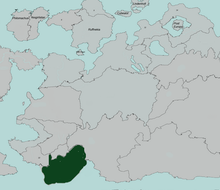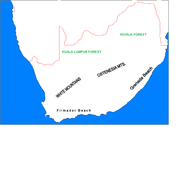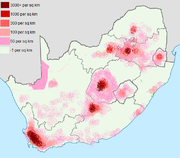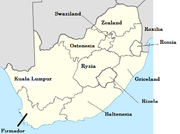Nation/Rizealand
| Federation of Rizealand | ||||||
|---|---|---|---|---|---|---|
|
||||||
| Motto: | ||||||
| Anthem: "God Bless Rizealand" | ||||||
| Capital | Monegro | |||||
| Largest city | Bagropa | |||||
| Demonym | Rizealander | |||||
| Government | Federal presidential republic | |||||
| - | President | Dominique Horiatio (NPC-NDP) | ||||
| - | Deputy-President | Stephen Crew (NPC-PDU) | ||||
| - | Speaker of the Assembly | Mary Aginold (NPC-NDP) | ||||
| - | Chief Justice | Oscar Desino | ||||
| Legislature | Parliament | |||||
| - | Upper house | National Council | ||||
| - | Lower house | National Assembly | ||||
| Independence from Great Britain | ||||||
| - | Declared | June 13, 1931 | ||||
| - | Recognized | August 5, 1931 | ||||
| - | Articles of Federation | September 9, 1931 | ||||
| Area | ||||||
| - | Total | 1,268,756 km2 490,874 sq mi |
||||
| - | Water (%) | 1.5 | ||||
| Population | ||||||
| - | 2014 estimate | 393,000,000 | ||||
| - | Density | 309.7/km2 800.6/sq mi |
||||
| GDP (PPP) | 2014 estimate | |||||
| - | Total | $1.824 trillion | ||||
| - | Per capita | $4,641 | ||||
| Gini (2014) | 0.13 low |
|||||
| HDI (2014) | very high |
|||||
| Currency | Rizealander Rizal ($) (RZR) |
|||||
| Time zone | (UTC+2) | |||||
| Drives on the | left | |||||
| Calling code | +31 | |||||
| ISO 3166 code | RZ | |||||
| Internet TLD | .rz | |||||
Etymology
The name Rizealand comes from the Maxtopian world Rizeya which is translated "Sunny" or "bright." The name was first used by British explorer Julian Edward. He called the land the "Sunny Land" or "Land of Rizeya." Different variations of Rizeya were used by the many different colonies in Rizealand. When Rizealand was confederated in 1870, they reversed land of Rizeya to Rizeyaland. The name was the Anglicized to Rizealand. The name was adopted as the new name by the colonial Parliament. The Articles of Federation officially state Rizealand's name.
History
Pre-Contact Rizealand
Rizealand was inhabited by at least two different tribal groups, the Maxtopians and the Bigtopians. The Maxtopians usually lived along the sea in the southern part of Rizealand and up in the north-western half along the Orange River. The Maxtopians in Rizealand divided themselves into the Kuali (inhabited the area along the Orange River) and the Rangu (who inhabited the coastal areas of southern Rizealand). The Maxtopians were usually a very peaceful people and were pretty cultured, as compared the Bigtopians who were more war-like and savage. The Bigtopians occupied the eastern and northeastern parts of the country around the Crimson River.European Contact and Settlement
The first European contact came in 1579 when a English explorer by the name of Francis Smith discovered Rizealand. He stopped near present day Bagropa for repairs. Julian Edward later arrived in 1608 and founded the Colony of Edwardton near present-day Bagropa. In 1640, the Colony of Edwardton fell under control of the newly created South Sunalayan Company who renamed the zone, the Colony of South Sunalaya. French explorers arrived at the eastern half of the country in 1680 and began to journey inland in search of trade and plantations. They were led by Louis LaSalle who founded LaSalle's Fort (later becoming the City of La Salle). LaSalle's fort struggled to survive in the harsh wilderness of Rizealand and under constant Bigtopian attacks. In 1690, the French sent more backup under command of French commander Louis DuBois who helped strengthen the frontier against Bigtopian attacks. The standoff between the Bigtopians results in the French-Bigtopian War of 1690. The war ended in 1701 with a massive massacre known as the Massacre of Fodante in which French settlers surprised attacked a Bigtopian village and killed 500 unarmed Bigtopians, most of whom were women and children.In 1739, a colonial military general by the name of General George Breyer, marched with a colonial militia of some 800 men and attacked Fort LaSalle. After thesiege, the small French colony surrendered and was put under control of the South Sunalayan Company, renamed the Colony of Ryzia. The port of New Grice was built in 1741 as another major seaport in which goods from LaSalle (as it was renamed) could be shipped to Britain. In 1789, a former British veteran from the American Revolutionary War named Daniel Rox arrived and established the town of Rox City. He was granted a charter by the South Sunalayan Company to create the Colony of Roxilia. In 1812, huge numbers of German, Spanish, and French immigrants began arriving in Ryzia and Roxilia to escape the constant bloodshed under the reign of Napoleon.
Confederation and Sovereignty
In 1839, numerous protests began to rise up all throughout Edwardton and Ryzia against the amount of corruption and dominance in which they resided under the rule of the South Sunalayan Company. In 1840, the Revolution of 1840 exploded in which colonists from Edwardton and Ryzia damaged goods for sale, blocked the highways, and attempted to attack South Sunalayan Company trade offices. The South Sunalayan Company however called in British troops who soon quelled the rebellion and squashed any resistance. The South Sunalayan Company however was dissolved in 1867 and in 1870, the British Parliament approved a request by the three colonies to be confederated. The colonies of Edwardton, Ryzia, and Roxilia sent delegates to a small convention in Edwardton where they drafted the Constitution for the new Royal Confederation of Edwardton, Ryzia, and Roxilia. However, they convention soon after changed the name to "Rizealand." They also designated the capital to be a newly built small town between their colonies on neutral ground called Monegro. In 1898, a civil war erupted in which parts of Roxilia and Ryzia tried to secede from the confederation but the rebellion was crushed by the new militias organized by the government. The Maxtopian-Bigtopian Wars (Rizealand) erupted in early 1905 as Maxtopians and Bigtopians rebelled against the government, upset at the amount of discrimination happening and their land rights being infringed. The massive war ended in 1915 but guerrila warfare, being practiced by the natives, continued on until 1925 when the government decided to grant them reservations.
Independence and Modern Times
Growing dissatisfaction with the inefficiency of the confederation, due to their handling of Maxtopian-Bigtopian Wars, nosedives in the economy, and a massive increase in taxes from Britain as a result of World War I cause the colonies of Rizealand to demand independence. On June 13, 1931, the Rizealander Parliament passed the Articles of Independence, requesting that the British Parliament grant the full autonomy. Because of the British Parliament's lack of appetite for war, their request was granted by the Treaty of Bagropa in August. The Parliament had meanwhile already begun drafting a plan for their new government, which entailed a federal government that greatly resembled that of the United States. Edwardton was also renamed Bagropa and the Province of Edwardton became the Province of Firmador. In September, the Articles of Federation were approved by the Parliament and the new government was formed.
Rizealand tried to stay out of World War II but after Britain had been bombed vy the German, Rizealand began to send over supplies and food to Britain. A small detachment of over 200 Rizealander soldiers also landed at the beaches of Normandy at D-Day. Rizealand joined the Commonwealth of Nations soon after its founding in 1949 and in 1952, Rizealand joined the United Nations. Rizealand also starts its own nuclear weapons program under the guidance of brilliant scientist Nicobar Coerdon. Rizealand joined the rest of the world in the race to the moon and sent its first rocket into space in 1976. In 1978, Rizealand was torn apart by riots from the Maxtopian and Bigtopian residents who demanded more civil rights like the right to vote and an end to anti-discriminatory laws in the Rizealand Civil Rights Movement of 1978. The protests eventually led to the desegregation of schools and equal suffrage for all in 1981. When the United Nations collapsed in 2008, Rizealand became a member of the new World Assembly. Rizealand has also recently joined the Sunalayan Union as well.
Geography
Rizealand is located on the southern peninsula of the central continent of Sunalaya. It has a coastline of more than 1,553 miles (2,500 km) that borders the Sunartic Ocean. At 490,874 square miles (1,268,756 sq km), Rizealand is the sixteenth largest country in Sunalaya and is comparable in size to Columbia. The highest point in Rizealand is White Mountain at 13,000 ft while the lowest point is the Sunartic Ocean at 0 ft. The land is more raised in the center of Rizealand but tapers down towards all its edges. Between Monegro and LaSalle are numerous mountain ranges, most prominently, the Ostenesia Mountain Range. This whole area is covered in thick forest, mostly bamboo, balboa, and palm trees as well as many other tropical trees. To the west of the Ostenesia Mountain Range is the White Mountains which contain some of the tallest peaks in Rizealand. These mountains are usually snow capped throughout the summer though recent dry spells have greatly reduced the amount of snow on top. The whole southwestern coastline of Rizealand is part of the Firmador Beach which is a very famous tourist destination for many people. Firmador Beach is characterized by light white sand and crystal blue water. The coastline of Firmador beach is very jagged and craggy in places, making it an idea spot for fishing and also providing natural harbors.
On the southeastern half, Rizealand's coast is called Grenada Beach. Here, the sand is darker and much coarser. Grenada Beach is much less popular than Firmador Beach due to its desolation. It however is a prime spot for fishing for stingrays and platypus. The northeastern part of the country is lower than the central part of the country and is home to much denser forests. The largest forest in the northeast is the Roxilia Forest which borders the Crimson River. The northwest is bordered by the Orange River which runs through the more tropical Kuala Lumpur Forest.
Climate
The climate of Rizealand is usually temperate but it had very frigid winters due to its proximity to Sunartica. Winter usually happens between June and August. Summer meanwhile usually happens between October and January with the rainy season in late November to early December. The southern part of Rizealand usually has cold dry winters and hot dry summers. Central Rizealand has much colder winters however and is usually hit by heavy snow storms and ice spells. Summer is much milder in central Rizealand due to their height. Along the Orange and Crimson Rivers, winters are usually very mild and summers are very humid and wet, with constant rainfall. The hottest place measured on record was Los Santos with a high of 110 degrees Fahrenheit and 100% humidity. The coldest temperature recorded was -50 degrees Fahrenheit in Monegro on June 25, 1997.
Biodiversity
Rizealand joined the Convention on Biological Diversity soon after it was founded 1992, under leadership of the new National Progress Coalition. Rizealand has been given a ranking of 102.75 out of 110 for the most biodiversity, above the world average of 32.5. Numerous animals including hyenas, cheetahs, black panthers, lions, hippopotamus, tigers, dingos, tapirs, anacondas, and piranhas are very numerous in most of the jungle areas of northern Rizealand. Mountain lions and bears tend to inhabit the more mountainous central regions and lions, hyenas, and wolves usually inhabited the southern parts. The Chiminese Parrot, which is also the national bird, is a very common tropical bird but in north there are toucans, parakeets, parrots, and such. The central mountains have more vultures, condors, hawks, eagles, and swallows while the southern areas have lots of pelicans, geese, and penguins. Common sea animals include humpback whales, killer whales, seals, and different kinds of sharks. Rizealand is also home to huge collections of fungi and lichen. In Kuala Lumpur National Park alone, there have been estimated to be at least 7,000 different species of fungi. Also, at least 15% of the world's vegetation can be found in Rizealand from palm trees, bamboo, balboa trees, to massive oak, conifer, and shale trees.

Conservation
Rizealand has faced some environmental loss in the past. Currently, Rizealand is 24 out 26 for environmental care with before 1992, Rizealand's conservative administrations allowed uncontrolled drilling, mining, and foresting in national forests, causing huge amounts of trees to be cut down. Certain animals like the Striped Gazelle and the Yellow Crocodile went extinct as a result of such environmental abuse. Rizealand also suffers minor problems from water and air pollution. The government has made it mandatory for all carbon monoxide emissions to be restrained by filters and have imposed strict penalties on corporations that dump waste into the water. This has also resulted in the government control of some bigger corporations who have refused to follow federal environment guidelines.
Demographics
Population
The estimated current population of Rizealand is 393,000,000, according to data collected earlier in January of 2014. Rizealand is also home to 1.8 million refugees, immigrants, and non-citizen residents. Most immigrants have come from Smoya, The Red Star Union, United Soviet Jason Republic, Dictatorship of Peace or Death, Farendale, and Cill Arne. Rizealand is also a very diverse as well, due to its multi-national creation. From early 2014 census figures, 78% are white, 15% are black, 6% are indigenous, and 1% stated they were "another race." The most populous white racial group is British-Rizealanders followed by French-Rizealanders, German-Rizealanders, and Spanish-Rizealanders. Half indigenous and half white people are also very common as well. Also, about 3.8% of the population has stated openly that they are gay, lesbian, or bisexual. The average fertiliy ratio is 1.5 children born per woman. About 82% of the population is located in urban areas.Religion
Rizealand use to traditionally be Anglican due to their British ties but after their independence, Rizealand followed the United States's example and chose to establish no national religion, allowing for the free exercise and practice of religion throughout Rizealand. Sixty-one percent of all Rizealanders polled professed to not have a religion and to be either agnostic or atheist. Twenty percent of Rizealanders profess to be Christian with 35% Anglican, 31% Protestant, 15% Roman Catholic, and 19% non-Denominational. Five percent of Rizealanders claim to be Mormons, 4% claim to be Jehovah Witnesses, 6% claim to be Jewish, 2% claim to be Muslim, and another 2% still follow their indigenous religious practices.
| Affiliation | % of Rizealand population | |
|---|---|---|
| No Faith | 61% | |
| Christian | 20% | |
| Protestant | 31% | |
| Anglican | 35% | |
| Roman Catholic | 15% | |
| Non-Denominational | 15% | |
| Judaism | 6% | |
| Mormon | 5% | |
| Jehovah Witness | 4% | |
| Muslim | 2% | |
| Indigenous religions | 2% | |
| 100 | | |
Languages
English is the official language of Rizealand and all provinces use English as their official language as well. However, the most commonly used languages are English 61%, French 15%, German 14%, Spanish 6%, Bigtopian 2%, and Maxtopian 2%. Despite having English as an official language, most provincial governments are required to post bilingual signs in areas of high language diversity.
Largest Cities of Rizealand
| Rank | City Name | Population |
|---|---|---|
| 1 | Bagropa | 35,000,000 |
| 2 | Monegro | 25,000,000 |
| 3 | La Salle | 20,000,000 |
| 4 | Balta | 19,100,000 |
| 5 | Rolando | 14,000,000 |
| 6 | DuBois | 10,500,000 |
| 7 | Acre | 10,100,000 |
| 8 | Los Santos | 6,500,000 |
| 9 | Osterleich | 6,000,000 |
| 10 | Rizela City | 3,000,000 |
Government and Politics
Rizealand is a federation or also called a democratic, presidential, federal republic. The government is based on a series of checks and balances. Its founding document, the Articles of Federation, is the supreme law of the land. All legislative power is vested in what is traditionally called Parliament after the British Parliament. The Parliament of Rizealand is bicameral and is unique in the way that each of its houses acts independently of the other one. The upper house or the National Council contains 33 seats and every Provincial legislature appoints 3 members for a term of five years. The National Council is tasked with ratifying treaties, approving government appointments, approving military requests, approving laws that regard Rizealand's security, and removing government officials from office. The National Assembly is the lower house and its 100 members are elected by popular vote from proportional districts for 3 years terms. The National Assembly has the power to create/disband government programs, appropriate funds, approve and establish the budget, pass all laws beneficial to the people, and to impeach government officials. The National Progress Coalition is currently the ruling party in National Assembly (50 out of 100 seats) and also in the National Council (19 out of 33 seats). The National Council and National Assembly meet in separate buildings, the National Council meets in the National Council Building and the National Assembly meets in the National Assembly Building. Both buildings are located in the capital of Monegro.
The Executive Branch is headed by the President of the Federation who is the chief of state and head of government for Rizealand. He is the Commander-in-Chief of Rizealand's armed forces and has the power to veto legislation passed by Parliament (but Parliament can override his veto with a 2/3 majority). He also appoints all federal judges and officers will approval of the National Council. The President is elected by an electoral college for one five year term and can serve only for a total of two terms. The President can be impeached by Parliament for breaking major laws or committing undesirable offenses. The President usually resides in The Orange House which serves as his Presidential residence although his main office is located in the Federal Executive Building of Rizealand in downtown Monegro. The electoral college, that appoints the President, also appoints a Deputy-President who can succeed the President during a vacancy, act as his aide and adviser, and who also is the "Chief Deputy" of the National Council
The Judicial Branch is composed of the Supreme Court of Rizealand, established as the highest appellate court in the land and also as a Constitutional court charged with reviewing government acts and having the power to strike them down as unconstitutional, Federal Courts of Appeal of Rizealand (established as an appeal court for all civil and non-criminal related cases), and the Federal District Courts of Appeal of Rizealand, established as a criminal court for major offenses that are beyond provincial jurisdiction.
Administrative Divisions
Rizealand is a federal union of 11 provinces. At first, only three provinces composed the federation but as time went on, more and more provinces were created and formed. Rizealand also recognizes the sovereignty of the three Maxtopian and Bigtopian tribal reservations in Rizealand: Mujamba Reservation, Kuali Reservation, and Tomar Reservation. Each province has a governor who is elect by the popular vote, a provincial assembly elected by the people for making laws, and a small judiciary composed of appellate and trial courts whose judges are usually appointed by either the governor, people, or provincial assembly. Each Province also has its own flag, Articles of Constitution, and its own laws. Provinces have been given certain rights over certain issues although in recent times, the federal government has expanded more into their domain.
| Province | Provincial capital | Largest city | Area (sq km) | Population (2014) |
|---|---|---|---|---|
| Baltenesia | Monegro | Monegro | 168,966 | 75,000,000 |
| Firmador | Bagropa | Bagropa | 129,462 | 85,000,000 |
| Griceland | New Grice | New Grice | 94,361 | 15,140,000 |
| Kuala Lumpur | Napa | Napa | 372,889 | 22,000,000 |
| Ostenesia | Osterleich | Osterleich | 104,882 | 22,500,000 |
| Rizela | Rizela City | Rizela City | 30,355 | 24,000,000 |
| Rossia | Rox City | Rox City | 17,364 | 10,000,000 |
| Roxilia | Roxil City | Roxil City | 76,495 | 23,700,000 |
| Ryzia | LaSalle | LaSalle | 129,825 | 68,060,000 |
| Swaziland | DuBois | DuBois | 18,178 | 24,600,000 |
| Zealand | Los Santos | Los Santos | 125,754 | 23,000,000 |
Political Parties
Rizealand has been divided up into two major political coalitions: the Triparte Nationalist Coalition and the National Progress Coalition. The Triparte National Coalition (TNC) is a conservative coalition of the Nationalist Republican Party (fiscal conservatives), Christian Democratic Party (center, moralist party), and Conservative Reform Party (grassroots libertarianism). The National Progress Coalition (NPC) is a liberal coalition of the New Democratic Party (social liberals), People's Democratic Union (older wing of social and fiscal liberals), Progressive Nationalist Party (grassroots extreme liberalism), and the Green Party. A smaller party known as the Socialist Party of Rizealand also holds some power as well. Currently, the NPC controls the National Council, National Assembly, and roughly less than half of the governor positions. The President of Rizealand is currently a member of the NPC as well. The Socialist Party however also has members in the National Assembly and has one governor's seat.









